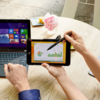While it is clear that businesses are comfortable conceptually with Anywhere, Anytime and Anyway, Any Device or BYOD (Bring Your Own Device) presents a myriad of ongoing integration issues. First, Windows is still the primary operating system for businesses worldwide on the desktop and portable computing platforms (laptops). This requires IT departments to begin any development effort with Windows as the first listed OS. However, the future is not just portable computing, it is wireless computing. And that results in a paradigm shift where tablets and smartphones must be included in the development effort. These devices not only represent different operating systems, they present the challenge of different presentation formats along with varying functionality.
Tablets represent the smaller and simpler market with only two dominant operating systems, iOS and Android. iOS (iPad) has 56.7% market share with Android growing rapidly at 41.3% according to Strategy Analytics. All others are make up 2% and can be relatively ignored by IT when it comes to integrating them into business support systems. Certainly, Microsoft faces an uphill battle with Windows 8 and Surface in gaining a foothold in this space. Moreover in terms of volume, globally 24.7 million tablets were sold versus 179.7 million smartphones in the third quarter of this year. Therefore, IT departments can lower the priority for tablets and place smartphones as the second most important method of computing.
A single company, Samsung, with twice the sales of its next competitor, dominates the global smartphone market. Samsung has a smartphone market share of 31% with Apple number two at 15%. According to IDC, the laggards (RIM, ZTE and HTC) are all at approximately 4% using third quarter numbers. It is clear that Android and iOS are dominating the market and require the attention of IT managers in developing application interfaces. RIM remains a force only because of its install based, which still exceeds 80 million users.
Any device or BYOD is not a simple proposition. It requires businesses to review internal policies and practices to determine if any device is an option or should there be a short list of acceptable devices. Smartphones represent the fastest growing segment of mobile computing. They represent 40% of all wireless handsets sold with the expectation that the market share will continue to grow as prices drop, functionality increases and users replace aging technology.
Half of all businesses have accepted the concept of BYOD with the other half knowing that it will be difficult to stop the trend. That said, it is very important to establish usage guidelines and security policies that cover these highly desired devices. It is also important to understand what elements of applications need to be available on given devices. For example, is video collaboration a requirement for smartphones? The answer will vary from business to business and by application. Any device is not a given.












Leave a comment